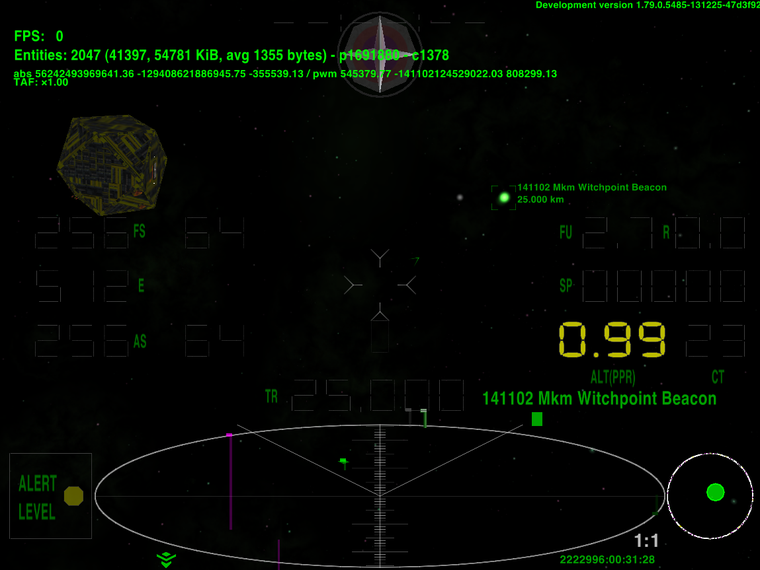[WIP] FarPlanets OXP v0.4 (Oolite 1.79 recommended)
Posted: Fri Jan 17, 2014 6:01 am
[wiki]FarPlanets[/wiki] OXP is populate the outer space of solar systems and provide travel methods to reach these far away places in reasonable time.
The first test version is done which create planets in Lave to try out the new drives. Later contracts will be made for far planets, but currently the only thing what you can do is to install [wiki]Stations_for_Extra_Planets[/wiki] (which has a brand new version, thanks spara!) to be able to trade and refuel after a long journey.
[wiki]DeepSpacePirates[/wiki] is also suggested due to no built-in similar functionality (yet ).
).
![[EliteWiki]](/images/elitewikismall.png) NumericHUD and [wiki]Telescope[/wiki] are updated to work with FarPlanets and measure the very large distances which are realistic in Oolite 1.79 and reduced in 1.77. Planet sizes are realistic also.
NumericHUD and [wiki]Telescope[/wiki] are updated to work with FarPlanets and measure the very large distances which are realistic in Oolite 1.79 and reduced in 1.77. Planet sizes are realistic also.
Speed is limited in all travel methods by the distance of the nearest mass. You must go farther from the sun than the main planet and witchpoint to get any more than the normal Torus speed.
Travel methods:
1. Forwarding:
Your ship theoretically is not faster but your clock will be adjusted forward to shorten the boring parts of travel (but TAF is not used so everything is working in deployment versions also). Is not the best way if you have time limited contracts.
My stress-test was succesful using this method on an exceptionally large distance: I reached the planet Sedna at his aphelion within 15 minutes in real life (when I turned off the limits described below). Small problem is that the time adjustment is finished 2.5 hours later and my pilot is probably died during the elapsed 139 years.

2. Micro-G Torus:
Must buy this equipment to get the same speeds than in the previous case but without time adjustment. This is a very good drive far from the sun which is limited by the lightspeed only.
To step over a bit, these two method will be used together if possible. In this case the limit is 9 times of the lightspeed which mean the Micro-G provide 0.9 lightspeed and the remain is covered by a 10x time adjustment.
Using this way you can arrive to the Mercury and an Earth-type planet also within your cup of tea break. But Jupiter need about half an hour and there are much farther planets also. To get a view check this map:

So you need something faster than light to reach Pluto within 24 hours. Here it comes:
3. FTL Torus:
You can burning fuel and using energy to get more from your Torus, where the rules are the same but additionally the gravity of the galaxy is coming into the picture which give the limit of this method due to constant in the whole system. The current background calculation is based on this Micro-g table.
Using a full tank fuel you should be able to reach the Pluto in tea time.
But still a challenge to reach comets in the Oort-Cloud.
This is the current WIP state, I am curious to your opinions.
Details and download in the wiki: [wiki]FarPlanets[/wiki]
The first test version is done which create planets in Lave to try out the new drives. Later contracts will be made for far planets, but currently the only thing what you can do is to install [wiki]Stations_for_Extra_Planets[/wiki] (which has a brand new version, thanks spara!) to be able to trade and refuel after a long journey.
[wiki]DeepSpacePirates[/wiki] is also suggested due to no built-in similar functionality (yet
Speed is limited in all travel methods by the distance of the nearest mass. You must go farther from the sun than the main planet and witchpoint to get any more than the normal Torus speed.
Travel methods:
1. Forwarding:
Your ship theoretically is not faster but your clock will be adjusted forward to shorten the boring parts of travel (but TAF is not used so everything is working in deployment versions also). Is not the best way if you have time limited contracts.
My stress-test was succesful using this method on an exceptionally large distance: I reached the planet Sedna at his aphelion within 15 minutes in real life (when I turned off the limits described below). Small problem is that the time adjustment is finished 2.5 hours later and my pilot is probably died during the elapsed 139 years.

2. Micro-G Torus:
Must buy this equipment to get the same speeds than in the previous case but without time adjustment. This is a very good drive far from the sun which is limited by the lightspeed only.
To step over a bit, these two method will be used together if possible. In this case the limit is 9 times of the lightspeed which mean the Micro-G provide 0.9 lightspeed and the remain is covered by a 10x time adjustment.
Using this way you can arrive to the Mercury and an Earth-type planet also within your cup of tea break. But Jupiter need about half an hour and there are much farther planets also. To get a view check this map:

So you need something faster than light to reach Pluto within 24 hours. Here it comes:
3. FTL Torus:
You can burning fuel and using energy to get more from your Torus, where the rules are the same but additionally the gravity of the galaxy is coming into the picture which give the limit of this method due to constant in the whole system. The current background calculation is based on this Micro-g table.
Using a full tank fuel you should be able to reach the Pluto in tea time.
But still a challenge to reach comets in the Oort-Cloud.
This is the current WIP state, I am curious to your opinions.
Details and download in the wiki: [wiki]FarPlanets[/wiki]

